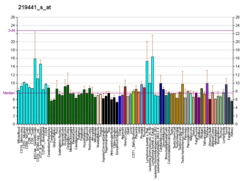LRRK1
Leucine-rich repeat serine/threonine-protein kinase 1 is an enzyme that in humans is encoded by the LRRK1 gene.[3][4][5]
References
- ↑ "Human PubMed Reference:".
- ↑ "Mouse PubMed Reference:".
- ↑ Nagase T, Nakayama M, Nakajima D, Kikuno R, Ohara O (May 2001). "Prediction of the coding sequences of unidentified human genes. XX. The complete sequences of 100 new cDNA clones from brain which code for large proteins in vitro". DNA Res. 8 (2): 85–95. PMID 11347906. doi:10.1093/dnares/8.2.85.
- ↑ Bosgraaf L, Van Haastert PJ (Dec 2003). "Roc, a Ras/GTPase domain in complex proteins". Biochim Biophys Acta. 1643 (1-3): 5–10. PMID 14654223. doi:10.1016/j.bbamcr.2003.08.008.
- ↑ "Entrez Gene: LRRK1 leucine-rich repeat kinase 1".
Further reading
- Maruyama K, Sugano S (1994). "Oligo-capping: a simple method to replace the cap structure of eukaryotic mRNAs with oligoribonucleotides.". Gene. 138 (1-2): 171–4. PMID 8125298. doi:10.1016/0378-1119(94)90802-8.
- Bonaldo MF, Lennon G, Soares MB (1997). "Normalization and subtraction: two approaches to facilitate gene discovery.". Genome Res. 6 (9): 791–806. PMID 8889548. doi:10.1101/gr.6.9.791.
- Suzuki Y, Yoshitomo-Nakagawa K, Maruyama K, et al. (1997). "Construction and characterization of a full length-enriched and a 5'-end-enriched cDNA library.". Gene. 200 (1-2): 149–56. PMID 9373149. doi:10.1016/S0378-1119(97)00411-3.
- Strausberg RL, Feingold EA, Grouse LH, et al. (2003). "Generation and initial analysis of more than 15,000 full-length human and mouse cDNA sequences.". Proc. Natl. Acad. Sci. U.S.A. 99 (26): 16899–903. PMC 139241
 . PMID 12477932. doi:10.1073/pnas.242603899.
. PMID 12477932. doi:10.1073/pnas.242603899. - Ota T, Suzuki Y, Nishikawa T, et al. (2004). "Complete sequencing and characterization of 21,243 full-length human cDNAs.". Nat. Genet. 36 (1): 40–5. PMID 14702039. doi:10.1038/ng1285.
- Gerhard DS, Wagner L, Feingold EA, et al. (2004). "The status, quality, and expansion of the NIH full-length cDNA project: the Mammalian Gene Collection (MGC).". Genome Res. 14 (10B): 2121–7. PMC 528928
 . PMID 15489334. doi:10.1101/gr.2596504.
. PMID 15489334. doi:10.1101/gr.2596504. - Korr D, Toschi L, Donner P, et al. (2006). "LRRK1 protein kinase activity is stimulated upon binding of GTP to its Roc domain.". Cell. Signal. 18 (6): 910–20. PMID 16243488. doi:10.1016/j.cellsig.2005.08.015.
- Zody MC, Garber M, Sharpe T, et al. (2006). "Analysis of the DNA sequence and duplication history of human chromosome 15.". Nature. 440 (7084): 671–5. PMID 16572171. doi:10.1038/nature04601.
- Haugarvoll K, Toft M, Ross OA, et al. (2007). "Variants in the LRRK1 gene and susceptibility to Parkinson's disease in Norway.". Neurosci. Lett. 416 (3): 299–301. PMID 17324517. doi:10.1016/j.neulet.2007.02.020.
- Ewing RM, Chu P, Elisma F, et al. (2007). "Large-scale mapping of human protein-protein interactions by mass spectrometry.". Mol. Syst. Biol. 3 (1): 89. PMC 1847948
 . PMID 17353931. doi:10.1038/msb4100134.
. PMID 17353931. doi:10.1038/msb4100134. - Greggio E, Lewis PA, van der Brug MP, et al. (2007). "Mutations in LRRK2/dardarin associated with Parkinson disease are more toxic than equivalent mutations in the homologous kinase LRRK1.". J. Neurochem. 102 (1): 93–102. PMID 17394548. doi:10.1111/j.1471-4159.2007.04523.x.
This article is issued from
Wikipedia.
The text is licensed under Creative Commons - Attribution - Sharealike.
Additional terms may apply for the media files.
